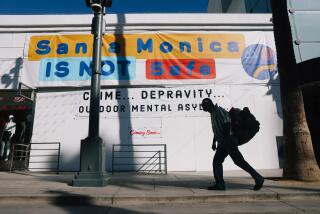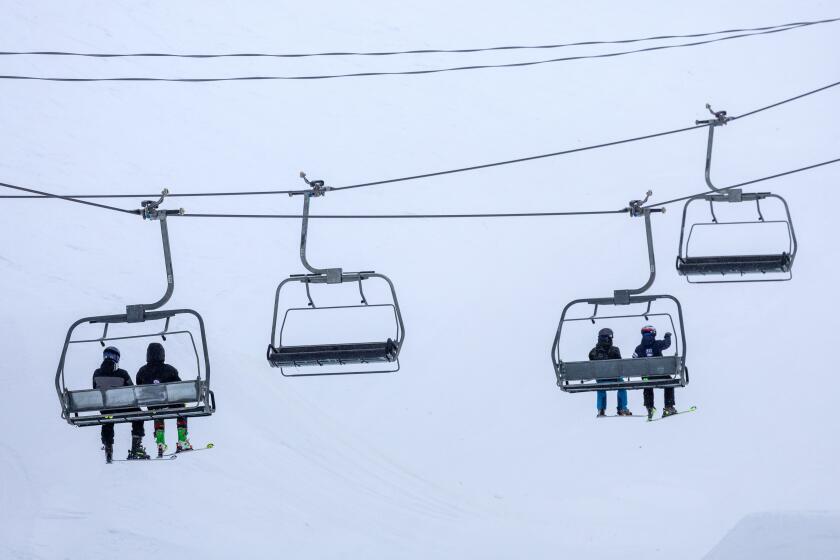Santa Ana Council Takes Back Seat in Traffic Issue
- Share via
Sitting in the Santa Ana City Council chambers recently, a song from the Broadway musical “The Best Little Whorehouse in Texas” kept running through my mind.
No, I was not thinking of prostitutes.
I was remembering the little diddle, “The Sidestep”--a tune sung by the governor as he dodged public questioning over whether an infamous whorehouse in the heart of rural Texas should be closed down.
“Ooooooohhh, I love to dance a little sidestep. Now they see me, now they don’t. I’ve come and gone,” intoned the governor as he ran circles around the pillars in the state Capitol.
And if you listened to complaints by many citizens at the council meeting that recent evening, you would think there was a whole lot of sidesteppin’ going on at the best little City Hall in Santa Ana.
The issue was not a whorehouse, nor was it the annual discussion about raising taxes. The debate was over a nagging problem that Southern Californians face everyday-- traffic.
Alarmed by potentially dangerous traffic congestion caused by the “Orange Crush” freeway interchange reconstruction in northwest Santa Ana, a group of well-intentioned residents formed the Floral Park Traffic Committee to find a solution. The result was a 13-point plan aimed at keeping commuters from short-cutting through their neighborhood, located north of 17th Street, between Bristol Street and Broadway. If approved, they said, their children would be able to safely walk to their neighborhood school.
But the committee’s hopes for quick and easy implementation of the plan hit a roadblock when some neighbors--left out of the initial planning process--rose in opposition and claimed it was ill-conceived because it merely would push the traffic onto other streets not currently affected. They also charged it was an elitist attempt to build a fortress and keep outsiders away from the neighborhood.
The council and its staff did not need a thermometer at their last meeting to gauge the tempers of citizens on this issue. This one, they could see, was too hot to handle, and most council members remained silent on the issue during the lengthy meeting.
Because of Mayor Daniel H. Young’s absence, Mayor Pro Tem Miguel A. Pulido Jr. was charged with establishing the ground rules for the public hearing. But then he changed the rules without advising the opponents of the plan.
Councilman John Acosta, who represents the area, deferred to the city staff all questions about how the issue would be resolved.
And one citizen swore she saw Councilman Daniel E. Griset thumbing through a newspaper supplement commemorating the 50th anniversary of the Japanese attack on Pearl Harbor. Griset, however, explained at the conclusion of the meeting that his silence on all agenda items that evening was caused by a bout with the flu.
The council’s position, or lack of it, may have been best explained by Councilwoman Patricia A. McGuigan when she said they had been bombarded by calls from citizens urging an immediate solution, versus those who thought the city should take on the more time-consuming responsibility of developing a traffic plan.
“I live on the west end of town,” McGuigan said. “There’s no way I am going to tell you how to run your daily lives. You are the ones that are going to have to find your way in and out, you are the ones that are ultimately going to have to decide, and I don’t want that hanging around my neck.”
Doesn’t the council run the people’s lives when it approves tax increases, or when it decides to tear down city blocks as part of redevelopment projects? one citizen would ask later.
But on a motion made by Councilman Robert L. Richardson, the council effectively told the citizens to slug it out among themselves at four public hearings on the Floral Park plan and try to reach a consensus. The meetings would be monitored by city staff but conducted by the Floral Park Traffic Committee, unless staff was requested to play a larger role.
Councilman Richards L. Norton, who strongly argued that the city staff develop an alternative plan because citizens were not traffic experts, swung over to the other side and became part of the unanimous vote in support of the motion.
Perhaps Norton was convinced by City Manager David N. Ream’s argument that staffers were intentionally limiting their input in the early stages because they wanted the public to clearly understand that this was not a “city” plan, but one developed by the neighborhood group.
“The right traffic plan for this neighborhood is going to be a plan that reaches a consensus,” Ream told the council.
Under the city’s normal procedures, city staffers provide technical assistance in the early stages of a neighborhood’s efforts to develop a traffic plan. But in this case, the staff will not formally review and comment on the plan until the community decides which elements are supported by two-thirds of the residents. If work proceeds as scheduled, the council could make a final decision in March.
It is a sticky situation for everyone involved.
The first town hall meeting on the plan Wednesday produced a raucous shouting match among a crowd of about 150 residents who were evenly split on the issue. The next evening, the crowd was smaller and quieter, with opponents slightly outnumbering supporters of the plan.
Although reluctant at first to compromise, the Floral Park group may have to modify its plan.
Meanwhile, Suszan Ales, who has helped spearhead opposition, said her side has developed an alternative that will be hand-delivered to homes instead of being presented at the final two hearings, because opponents feel disenfranchised by the process.
“I want some guarantees that it does not go in the trash can,” she said.
The city manager, who lives in the area, also can expect tough questioning from his neighbors.
And sooner or later, the council will have to take a position.
Unlike previous council debates that involved the homeless or pushcart vendors--groups that traditionally do not turn out at the polls--these citizens are activists.
No matter how the council members vote, they run the risk of alienating about half of the neighborhood residents.
And that’s what makes the “sidestep” such an interesting dance to watch.
More to Read
Sign up for Essential California
The most important California stories and recommendations in your inbox every morning.
You may occasionally receive promotional content from the Los Angeles Times.









